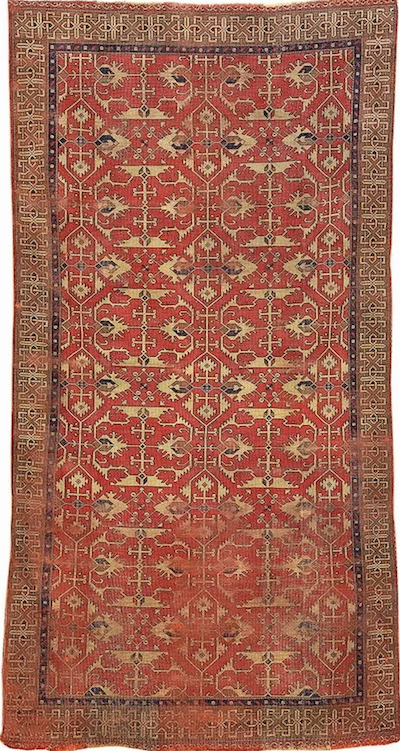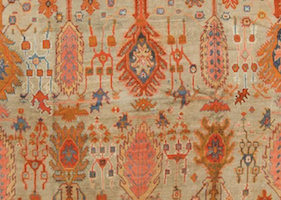
NEW YORK – During the Renaissance, European elites collected luxurious hand-woven textiles they called “Turkey” rugs, symbols of wealth and majesty imported from Oushak, Anatolia in the Ottoman Empire. Unlike more formal, tightly woven Persian pieces, they featured relatively long pile, fairly loose knots, and a relaxed design realized in rich, appealing shades of red, blue, gold and terracotta.
Because these exotic works of art were considered too precious to tread upon, they were usually draped on chests and tables or displayed as wall hangings. Yet in 1537, artist Hans Holbein created a magnificent image of Henry VIII of England with his feet planted squarely upon an Oushak “Turkey.”
Indeed, according to depictions and descriptions of the time, hand-woven rugs such as the one in the painting – featuring dominant star motifs framed by tiny repetitive geometric patterns and a variety of vibrant borders – became known as “Holbeins.” A brilliantly hued circa-1600 Oushak rug, which the Austria Auction Company sold for €150,000 (about $158,983) plus the buyer’s premium in September 2013, similarly features large, eight-pointed stars alternating with four-sided diamonds, all enclosed by arabesques and a continuous floral trellis.

As European scholars explored the history of Oushak rugs, they began associating differing patterns with Western artists who portrayed them. For example, those known as “Lotto” Oushaks, which feature small, lacy motifs branching into palmettes and arabesques, reference Lorenzo Lotto, a Venetian who depicted them in his religious works of art.

With the passage of time, Oushak rugs came to enhance church interiors as well as aristocratic dwellings. As they evolved, many retained their distinctive classic character, displaying large ovoid or star-shaped medallions enclosing elaborate, naturalistic rumi motifs and floral vine work. Others, such as the large beauty featuring a four-lobed star medallion, bold triangular forms divided by curving crosses, and continuous repeat borders that RIPPON Boswell & Co., International Auctioneers sold for €28,000 (about $29,474) plus the buyer’s premium in May 2022, boast dominant geometric motifs.

Demand for intricately designed Oushaks ultimately declined in favor of larger, simpler, easily produced pieces dubbed “medallion” floor carpets. By the 1880s, in addition to incorporating highly popular Persian-like floral patterns, these rugs became increasingly brighter, coarsely woven, and less sophisticated. Il Ponte Casa d’Aste Srl auctioned a huge, 19th-century palace-size example featuring all-over emerald green medallions interspersed with diamond designs against a ruby red ground for €3,000 (about $3,180) plus the buyer’s premium in April 2018.

By the early 20th century, weavers from outside Oushak were merging traditional, time-honored woven elements with an exciting range of imaginative patterns and colors. Yet all are still known as Oushaks.
Oushak rugs can be costly, with their auction prices depending on their age, rarity, size and condition. But because they are limited in number, they may hold or even increase their value. Their uniquely attractive manner of blending art, culture and history continues to fascinate collectors, dealers and decorators alike.


